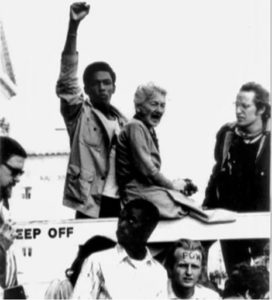In early May 1971, a year after six unarmed student war protestors were shot and killed by the National Guard (four at Kent State University and two at Jackson State University), I joined a mass protest in Washington. The goal was ambitious: shut down the city and speed the end of the Vietnam War.
According to some historians, it did. The tens of thousands of unarmed young demonstrators who came to Washington 50 years ago weren’t answering the call of any individual, but we were answering a call: “If the government won’t stop the war, we’ll stop the government.”
I was living with my husband and our daughter near the UConn campus in rural Connecticut, about as far from Vietnam as you could get. But we’d heard first-person reports from friends, and, along with millions of others far from the bombing, we’d seen horrific images and had absorbed years of nightly body counts on the news. We keenly felt the force of those numbers; the American dead were mostly from our generation. As a young mother, I was viscerally aware that the bodies of Vietnamese and Cambodian civilians, including children, were not being counted.

A friend offered a ride to Washington. Although I hadn’t yet spent a day away from my three-year-old, I left her with her father to join the multitudes gathering to speak out against the war. It wasn’t the biggest protest that had taken place, but it was the biggest one I’d ever seen. I have vivid memories that still evoke both the sense of danger and the exhilaration of taking a stand with so many others. Like most of those who arrived on Saturday, May 1, I left D.C. on Sunday. I was not arrested.
The May 1971 mass mobilization against the war wasn’t the first or the last, but it did provoke the largest mass arrest in U.S. history. By Tuesday, May 4, more than 12,000 protesters had been arrested. Why has it been forgotten? Although demonstrators were clubbed, beaten, and tear-gassed, no one was killed; protesters didn’t plant bombs, physically attack police, break windows, or invade government buildings. We maintained our commitment to nonviolence. Everyone marched and chanted, young men burned their draft cards, veterans threw away their medals, and “affinity groups” improvised barricades — and used their own bodies as well — to block commuter traffic, disrupting government business as usual.
One of the thousands arrested for waging nonviolence that May was my friend Anne McVey Upshure, a legendary peacenik who was 83 at the time. The late photographer Audrey Schirmer, then based in Truro and Cambridge, was there, too, and snapped a photo of Anne crying out. (She later explained she was upset because she was watching a young protester being “mercilessly beaten” by Nixon’s troops.) In the picture, one of Anne’s companions has P.O.W. painted on his forehead.
A young Black man standing next to Anne in the photo has his fist raised in a power salute, a symbol of solidarity in the Black Power movement, the mobilization against the war, and the budding movement for women’s liberation. In fact, the image of the fist was the logo imprinted on all the posters and leaflets announcing the demonstration.
I’m sure I’m not the only veteran of what we called “the movement” (decades before Steve Bannon swiped the phrase for his website) whose mind buckled when I saw the seditious young Missouri Sen. Josh Hawley pose for news cameras on Jan. 6, 2021, raising his clenched fist in solidarity with violent rioters. Those rioters, sent to the Capitol by President Trump, were also bent on disrupting government business — in their case, not the business of waging a disastrous war in Southeast Asia, but the business of certifying an election in the U.S.A.



